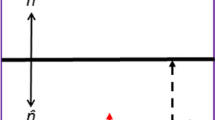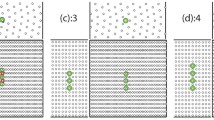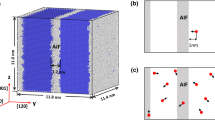Abstract
We use atomistic modeling to study the response of three non-coherent grain boundaries (GBs) in Cu to continuous loading with vacancies. Our simulations yield insights into the structure and properties of these boundaries both near and far from thermal equilibrium. We find that GB energies vary periodically as a function of the number of vacancies introduced. Each GB has a characteristic minimum energy state that recurs during continuous vacancy loading, but in general cannot be reached without removing atoms from the boundary. There is no clear correlation of GB energies with GB specific excess volumes or stresses during vacancy loading. However, GB stresses increase monotonically with specific excess volumes. Continuous vacancy loading gives rise to GB migration and shearing, despite the absence of applied loads. Successive vacancies introduced into some of the boundaries accumulate at the cores of what appear to be generalized vacancy dislocation loops. We discuss the implications of these findings for our understanding of grain boundary sink efficiencies under light ion irradiation.















Similar content being viewed by others
References
Dollar M, Gleiter H (1985) Point-defect annihilation at grain-boundaries in gold. Scripta Metall 19(4):481–484
Gleiter H (1979) Grain-boundaries as point-defect sources or sinks - diffusional creep. Acta Metall Mater 27(2):187–192
King AH, Smith DA (1980) On the mechanisms of point-defect absorption by grain and twin boundaries. Philos Mag A 42(4):495–512
Siegel RW, Chang SM, Balluffi RW (1980) Vacancy loss at grain-boundaries in quenched polycrystalline gold. Acta Metall Mater 28(3):249–257
Han WZ, Demkowicz MJ, Fu EG, Wang YQ, Misra A (2012) Effect of grain boundary character on sink efficiency. Acta Mater 60(18):6341–6351
Misra A, Demkowicz MJ, Zhang X, Hoagland RG (2007) The radiation damage tolerance of ultra-high strength nanolayered composites. Jom-Us 59(9):62–65
Misra A, Thilly L (2010) Structural metals at extremes. MRS Bull 35(12):965–976
Han WZ, Demkowicz MJ, Mara NA, Fu EG, Sinha S, Rollett AD, Wang YQ, Carpenter JS, Beyerlein IJ, Misra A (2013) Design of radiation tolerant materials via interface engineering. Adv Mater 25(48):6975–6979
Demkowicz MJ, Hoagland RG, Uberuaga BP, Misra A (2011) Influence of interface sink strength on the reduction of radiation-induced defect concentrations and fluxes in materials with large interface area per unit volume. Phys Rev B 84(10):104102
King AH, Smith DA (1981) Calculations of sink strength and bias for point-defect absorption by dislocations in arrays. Radiat Eff Defect Solids 54(3–4):169–176
Millett PC, Aidhy DS, Desai T, Phillpot SR, Wolf D (2009) Grain-boundary source/sink behavior for point defects: an atomistic simulation study. Int J Mater Res 100(4):550–555
Zhang YF, Huang HC, Millett PC, Tonks M, Wolf D, Phillpot SR (2012) Atomistic study of grain boundary sink strength under prolonged electron irradiation. J Nucl Mater 422(1–3):69–76
Singh BN (1974) Effect of grain-size on void formation during high-energy electron-irradiation of austenitic stainless-steel. Philos Mag 29(1):25–42
Ashby MF (1969) On interface-reaction control of nabarro-herring creep and sintering. Scripta Metall 3(11):837–842
Sutton AP, Balluffi RW (1995) Interfaces in crystalline materials. Clarendon Press, Oxford
Bristowe PD, Brokman A, Spaepen F, Balluffi RW (1980) Simulation of the structure of vacancies in high angle grain-boundaries. Scripta Metall 14(8):943–950
Brokman A, Bristowe PD, Balluffi RW (1981) Computer-simulation study of the structure of vacancies in grain-boundaries. J Appl Phys 52(10):6116–6127
Chen D, Wang J, Chen TY, Shao L (2013) Defect annihilation at grain boundaries in alpha-Fe. Sci Rep 3:1450
Demkowicz MJ, Anderoglu O, Zhang XH, Misra A (2011) The influence of Sigma 3 twin boundaries on the formation of radiation-induced defect clusters in nanotwinned Cu. J Mater Res 26(14):1666–1675
Rhodes NR, Tschopp MA, Solanki KN (2013) Quantifying the energetics and length scales of carbon segregation to alpha-Fe symmetric tilt grain boundaries using atomistic simulations. Model Simul Mater Sci 21(3):035009
Suzuki A, Mishin Y (2003) Interaction of point defects with grain boundaries in fcc metals. Interface Sci 11(4):425–437
Suzuki A, Mishin Y (2003) Atomistic modeling of point defects and diffusion in copper grain boundaries. Interface Sci 11(1):131–148
Sorensen MR, Mishin Y, Voter AF (2000) Diffusion mechanisms in Cu grain boundaries. Phys Rev B 62(6):3658–3673
Hahn W, Gleiter H (1981) On the structure of vacancies in grain-boundaries. Acta Metall Mater 29(4):601–606
Uberuaga BP, Bai XM, Dholabhai PP, Moore N, Duffy DM (2013) Point defect-grain boundary interactions in MgO: an atomistic study. J Phys Condens Matter 25(35):355001
Vitek V, Sutton AP, Gui Jin W, Schwartz D (1983) On the multiplicity of structures and grain boundaries. Scripta Metall 17(2):183–189
Vitek V, Minonishi Y, Wang G-J (1985) Multiplicity of grain boundary structures : vacancies in boundaries and transformations of the boundary structure. J Phys Colloques 46(C4):C4-171
Phillpot SR, Rickman JM (1992) Simulated quenching to the zero-temperature limit of the grand-canonical ensemble. J Chem Phys 97(4):2651–2658
Phillpot SR, Rickman JM (1992) Reconstruction of a high-angle twist grain-boundary by grand-canonical simulated quenching. Struct Prop Interfaces Mater 238:183–188
von Alfthan S, Haynes PD, Kaski K, Sutton AP (2006) Are the structures of twist grain boundaries in silicon ordered at 0 K? Phys Rev Lett 96(5):055505
Bai XM, Voter AF, Hoagland RG, Nastasi M, Uberuaga BP (2010) Efficient annealing of radiation damage near grain boundaries via interstitial emission. Science 327(5973):1631–1634
Bai XM, Vernon LJ, Hoagland RG, Voter AF, Nastasi M, Uberuaga BP (2012) Role of atomic structure on grain boundary-defect interactions in Cu. Phys Rev B 85(21):204103
Frolov T, Olmsted DL, Asta M, Mishin Y (2013) Structural phase transformations in metallic grain boundaries. Nat Commun 4:1899
Borovikov V, Tang XZ, Perez D, Bai XM, Uberuaga BP, Voter AF (2013) Influence of point defects on grain boundary mobility in bcc tungsten. J Phys Condens Matter 25(3):035402
Tucker GJ, McDowell DL (2011) Non-equilibrium grain boundary structure and inelastic deformation using atomistic simulations. Int J Plast 27(6):841–857
Kolluri K, Demkowicz MJ (2010) Dislocation mechanism of interface point defect migration. Phys Rev B 82(19):193404
Kolluri K, Demkowicz MJ (2012) Formation, migration, and clustering of delocalized vacancies and interstitials at a solid-state semicoherent interface. Phys Rev B 85(20):205416
Kolluri K, Demkowicz MJ, Hoagland RG, Liu XY (2013) Behavior of vacancies and interstitials at semicoherent interfaces. Jom-Us 65(3):374–381
Martínez E, Hirth JP, Nastasi M, Caro A (2012) Structure of a 2 degree (010) Cu twist boundary interface and the segregation of vacancies and He atoms. Phys Rev B 85(6):060101
Martínez E, Caro A (2012) Atomistic modeling of long-term evolution of twist boundaries under vacancy supersaturation. Phys Rev B 86(21):214109
Gavini V, Bhattacharya K, Ortiz M (2007) Vacancy clustering and prismatic dislocation loop formation in aluminum. Phys Rev B 76(18):180101
Sabochick MJ, Yip S, Lam NQ (1988) Atomistic simulation study of large vacancy clusters in copper. J Phys F 18(3):349
Demkowicz MJ, Hoagland RG, Hirth JP (2008) Interface structure and radiation damage resistance in Cu–Nb multilayer nanocomposites. Phys Rev Lett 100(13):136102
Cantwell PR, Tang M, Dillon SJ, Luo J, Rohrer GS, Harmer MP (2014) Grain boundary complexions. Acta Mater 62:1–48
Hasnaoui A, Van Swygenhoven H, Derlet PM (2002) On non-equilibrium grain boundaries and their effect on thermal and mechanical behaviour: a molecular dynamics computer simulation. Acta Mater 50(15):3927–3939
Kempshall BW, Prenitzer BI, Giannuzzi LA (2002) Grain boundary segregation: equilibrium and non-equilibrium conditions. Scripta Mater 47(7):447–451
Pumphrey PH, Gleiter H (1975) Structure of nonequilibrium high-angle grain-boundaries. Philos Mag 32(4):881–885
Randle V (1993) The measurement of grain boundary geometry. Institute of Physiscs Publishing, Bristol
Grimmer H (1976) Coincidence-site lattices. Acta Crystallogr A 32(5):783–785
Randle V (1998) Overview no. 127. The role of the grain boundary plane in cubic polycrystals. Acta Mater 46(5):1459–1480
Bollmann W (1970) Crystal defects and crystalline interfaces. Springer, Berlin
Tschopp MA, McDowell DL (2007) Structures and energies of Sigma 3 asymmetric tilt grain boundaries in copper and aluminium. Philos Mag 87(22):3147–3173
Daw MS, Baskes MI (1984) Embedded-atom method—derivation and application to impurities, surfaces, and other defects in metals. Phys Rev B 29(12):6443–6453
Mishin Y, Mehl MJ, Papaconstantopoulos DA, Voter AF, Kress JD (2001) Structural stability and lattice defects in copper: Ab initio, tight-binding, and embedded-atom calculations. Phys Rev B 63(22):224106
Bertsekas D (1999) Nonlinear programming. Athena Scientific, Belmont
Hoover WG (1985) Canonical dynamics—equilibrium phase-space distributions. Phys Rev A 31(3):1695–1697
Nose S (1984) A unified formulation of the constant temperature molecular-dynamics methods. J Chem Phys 81(1):511–519
Plimpton S (1995) Fast parallel algorithms for short-range molecular dynamics. J Comp Phys 117(1):1–19
Alexander S (2010) Visualization and analysis of atomistic simulation data with OVITO–the open visualization tool. Model Simul Mater Sci 18(1):015012
Daw MS, Foiles SM, Baskes MI (1993) The embedded-atom method: a review of theory and applications. Mater Sci Rep 9(7–8):251–310
Tschopp MA, McDowell DL (2007) Asymmetric tilt grain boundary structure and energy in copper and aluminium. Philos Mag 87(25):3871–3892
Tschopp MA, Solanki KN, Gao F, Sun X, Khaleel MA, Horstemeyer MF (2012) Probing grain boundary sink strength at the nanoscale: energetics and length scales of vacancy and interstitial absorption by grain boundaries in alpha-Fe. Phys Rev B 85(6):064108
Fensin SJ, Valone SM, Cerreta EK, Gray GT (2012) Influence of grain boundary properties on spall strength: grain boundary energy and excess volume. J Appl Phys 112(8):083529
Brown JA, Mishin Y (2007) Dissociation and faceting of asymmetrical tilt grain boundaries: molecular dynamics simulations of copper. Phys Rev B 76(13):134118
Rycroft CH, Grest GS, Landry JW, Bazant MZ (2006) Analysis of granular flow in a pebble-bed nuclear reactor. Phys Rev E 74(2):021306
Wolf D (1989) Correlation between energy and volume expansion for grain-boundaries in fcc metals. Scripta Metall 23(11):1913–1918
Cammarata RC (1994) Surface and interface stress effects in thin films. Prog Surf Sci 46(1):1–38
Spaepen F (2000) Interfaces and stresses in thin films. Acta Mater 48(1):31–42
Du D, Zhang H, Srolovitz DJ (2007) Properties and determination of the interface stiffness. Acta Mater 55(2):467–471
Birringer R, Zimmer P (2009) Grain- and phase-boundary stress effects in nanocrystalline materials. Acta Mater 57(6):1703–1716
Shull AL, Spaepen F (1996) Measurements of stress during vapor deposition of copper and silver thin films and multilayers. J Appl Phys 80(11):6243–6256
Kelchner CL, Plimpton SJ, Hamilton JC (1998) Dislocation nucleation and defect structure during surface indentation. Phys Rev B 58(17):11085–11088
Cahn JW, Mishin Y, Suzuki A (2006) Coupling grain boundary motion to shear deformation. Acta Mater 54(19):4953–4975
Seeger A, Schottky G (1959) Energy and electrical resistivity of high-angle grain boundaries in metals. Acta Metall Mater 7(7):495–503
Wolf D (1989) Structure-energy correlation for grain-boundaries in fcc metals.2. Boundaries on the (110) and (113) planes. Acta Metall Mater 37(10):2823–2833
Wolf D (1989) Structure-energy correlation for grain-boundaries in fcc metals.1. Boundaries on the (111) and (100) planes. Acta Metall Mater 37(7):1983–1993
Wolf D (1990) Structure-energy correlation for grain-boundaries in fcc metals.4. Asymmetrical twist (general) boundaries. Acta Metall Mater 38(5):791–798
Wolf D (1990) Structure-energy correlation for grain-boundaries in fcc metals.3. Symmetrical tilt boundaries. Acta Metall Mater 38(5):781–790
Wolf D (1990) Correlation between the energy and structure of grain-boundaries in bcc metals.1. Symmetrical boundaries on the (110) and (100) planes. Philos Mag B 59(6):667–680
Wolf D (1990) Correlation between the energy and structure of grain-boundaries in bcc metals.2. Symmetrical tilt boundaries. Philos Mag A 62(4):447–464
Olmsted DL, Foiles SM, Holm EA (2009) Survey of computed grain boundary properties in face-centered cubic metals: I. Grain boundary energy. Acta Mater 57(13):3694–3703
Olmsted DL, Buta D, Adland A, Foiles SM, Asta M, Karma A (2011) Dislocation-pairing transitions in hot grain boundaries. Phys Rev Lett 106(4):046101
Olmsted DL, Foiles SM, Holm EA (2007) Grain boundary interface roughening transition and its effect on grain boundary mobility for non-faceting boundaries. Scripta Mater 57(12):1161–1164
Was GS (2007) Fundamentals of radiation materials science: metals and alloys. Springer Verlag, Berlin
Duesbery MS, Vitek V (1998) Plastic anisotropy in bcc transition metals. Acta Mater 46(5):1481–1492
Spearot DE, Tschopp MA, Jacob KI, McDowell DL (2007) Tensile strength of 〈100〉 and 〈110〉 tilt bicrystal copper interfaces. Acta Mater 55(2):705–714
Rittner JD, Seidman DN (1996) 〈110〉 symmetric tilt grain-boundary structures in fcc metals with low stacking-fault energies. Phys Rev B 54(10):6999–7015
Rupert TJ, Schuh CA (2012) Mechanically driven grain boundary relaxation: a mechanism for cyclic hardening in nanocrystalline Ni. Phil Mag Lett 92(1):20–28
Vattre AJ, Demkowicz MJ (2013) Determining the Burgers vectors and elastic strain energies of interface dislocation arrays using anisotropic elasticity theory. Acta Mater 61(14):5172–5187
Vattre AJ, Abdolrahim N, Kolluri K, Demkowicz MJ (2014) Computational design of patterned interfaces using reduced order models. Sci Rep 4:6231
Hirth JP, Lothe J (1967) Theory of dislocations. McGraw-Hill, New York
Takahashi H, Hashimoto N, Kanda H (1996) Effects of excess point defects flow and interface orientation on grain boundary migration under irradiation. Interface Sci 4(3–4):221–228
Freund H-J (2002) Clusters and islands on oxides: from catalysis via electronics and magnetism to optics. Surf Sci 500(1–3):271–299
Li N, Wang J, Wang YQ, Serruys Y, Nastasi M, Misra A (2013) Incoherent twin boundary migration induced by ion irradiation in Cu. J Appl Phys 113(2):023508
Yu KY, Bufford D, Khatkhatay F, Wang H, Kirk MA, Zhang X (2013) In situ studies of irradiation-induced twin boundary migration in nanotwinned Ag. Scripta Mater 69(5):385–388
Yu KY, Bufford D, Sun C, Liu Y, Wang H, Kirk MA, Li M, Zhang X (2013) Removal of stacking-fault tetrahedra by twin boundaries in nanotwinned metals. Nat Commun 4:1377
Foiles SM, Medlin DL (2001) Structure and climb of 1/3 〈111〉 twin dislocations in aluminum. Mater Sci Eng 319:102–106
Medlin DL, Carter CB, Angelo JE, Mills MJ (1997) Climb and glide of a/3 〈111〉 dislocations in an aluminium σ = 3 boundary. Philos Mag A 75(3):733–747
Acknowledgements
MJD thanks A. P. Sutton and R. Birringer for useful discussions. This work was supported by the Center for Materials at Irradiation and Mechanical Extremes, an Energy Frontier Research Center funded by the U.S. Department of Energy, Office of Science, Office of Basic Energy Sciences under Award Number 2008LANL1026.
Author information
Authors and Affiliations
Corresponding author
Rights and permissions
About this article
Cite this article
Yu, W.S., Demkowicz, M.J. Non-coherent Cu grain boundaries driven by continuous vacancy loading. J Mater Sci 50, 4047–4065 (2015). https://doi.org/10.1007/s10853-015-8961-9
Received:
Accepted:
Published:
Issue Date:
DOI: https://doi.org/10.1007/s10853-015-8961-9




